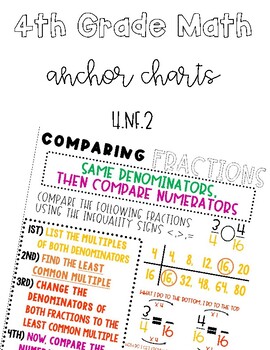Comparing Fractions with Unlike Denominators | Anchor Chart | Area Model
Shaw in the Classroom
1.1k Followers
Grade Levels
3rd - 8th
Subjects
Standards
CCSS3.NF.A.3d
CCSS4.NF.A.1
CCSS4.NF.A.2
CCSS5.NF.A.1
Formats Included
- PDF
Shaw in the Classroom
1.1k Followers
What educators are saying
I loved using this resource with my students. It is visually appealing, easy to follow, and very helpful to refer back to.
Students glued these notes into their math journals. It made an easy resource for students to refer back to when they felt confused.
Also included in
- Introducing our comprehensive Fourth Grade Math Mega Bundle – your one-stop solution for mastering all the fourth-grade math standards! This bundle combines all the digital step-by-step instruction products from our collection, offering a treasure trove of resources to support your students' math lePrice $63.00Original Price $71.50Save $8.50
- This 100% EDITABLE PowerPoint Presentation is perfect for introducing multiple methods for comparing fractions. The strategies included are finding common denominators, cross multiply, number line, model, and comparing to one half. By utilizing the pen feature on PowerPoint, you are able to draw rigPrice $4.00Original Price $5.00Save $1.00
- FITS THE 4th GRADE STANDARDS NUMBER AND OPERATIONS - FRACTIONSThese anchor charts are perfect for scaffolding your instruction for your students when teaching your class about fractions. It includes adding and subtracting fractions, multiplying fractions by a whole number, comparing fractions with uPrice $14.50Original Price $20.00Save $5.50
Description
This is the perfect math anchor chart for introducing how to compare fractions with unlike denominators. Using the least common multiple, it is easy for students to follow the color coded steps on the anchor chart. This digital anchor chart can be projected onto your favorite anchor chart paper and be traced for the perfect addition to your math wall.
There are two different versions of this anchor chart to help you differentiate for the each one of your students. One version has the steps going vertically and the other version has horizontal steps.
I have used this for end of the year test prep, guided practice, partner work, fraction games, fraction activities, test review, etc.
Total Pages
Answer Key
N/A
Teaching Duration
N/A
Report this resource to TPT
Reported resources will be reviewed by our team. Report this resource to let us know if this resource violates TPT’s content guidelines.
Standards
to see state-specific standards (only available in the US).
CCSS3.NF.A.3d
Compare two fractions with the same numerator or the same denominator by reasoning about their size. Recognize that comparisons are valid only when the two fractions refer to the same whole. Record the results of comparisons with the symbols >, =, or <, and justify the conclusions, e.g., by using a visual fraction model.
CCSS4.NF.A.1
Explain why a fraction 𝘢/𝘣 is equivalent to a fraction (𝘯 × 𝘢)/(𝘯 × 𝘣) by using visual fraction models, with attention to how the number and size of the parts differ even though the two fractions themselves are the same size. Use this principle to recognize and generate equivalent fractions.
CCSS4.NF.A.2
Compare two fractions with different numerators and different denominators, e.g., by creating common denominators or numerators, or by comparing to a benchmark fraction such as 1/2. Recognize that comparisons are valid only when the two fractions refer to the same whole. Record the results of comparisons with symbols >, =, or <, and justify the conclusions, e.g., by using a visual fraction model.
CCSS5.NF.A.1
Add and subtract fractions with unlike denominators (including mixed numbers) by replacing given fractions with equivalent fractions in such a way as to produce an equivalent sum or difference of fractions with like denominators. For example, 2/3 + 5/4 = 8/12 + 15/12 = 23/12. (In general, 𝘢/𝘣 + 𝘤/𝘥 = (𝘢𝘥 + 𝘣𝘤)/𝘣𝘥.)






